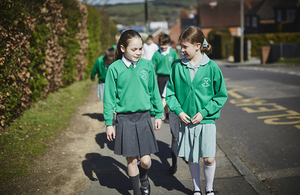Promoting walking in primary schools
Encouraging more children to walk to school.

| Location of intervention | Various cities across England |
| Contractor/delivery partner | Living Streets, Transport for Greater Manchester, Birmingham City Council, West Yorkshire Combined Authority, Merseytravel and West Midlands Combined Authority |
| Scheme implementation dates | 2016 to 2017 – 2019 to 2020 |
| Cost of scheme | £2.62 million from 2016 to 2017 and 2019 to 2020 |
| Funding source | Department for Transport |
| BCR | 2018 to 2019 programme |
Why we did it
Travelling to education is the most common single purpose of walking journeys but there is huge potential to increase the proportion of children walking to school. A generation ago, 70% of primary school children walked to school but this has dropped to just over half (51%).
The government has a target in its Cycling and Walking Investment Strategy (CWIS) to have 55% of primary school children walking to school by 2025.
How we did it
Living Streets, with support from the Department for Transport, has been running the Walk to School Outreach (WTSO) project since 2017. It does so mainly through behaviour change interventions delivered in schools, including WOW, Living Streets’ year-round walk to school challenge, and by influencing local infrastructure decisions.
What we did
Over the period 2018 to 2019 the WTSO project promoted walking in 275 primary schools including 133 new schools. The project is estimated to have encouraged around 10,000 extra children and around 2,500 extra adults to walk to school over this period.
What impact did it have
Final evaluation carried out at the end of March 2019 shows that walking rates increased by 38% among new WTSO project schools and increased walking rates were sustained in existing schools in 2018 to 2019. This represents around 4 million new walking trips and 1.3 million fewer school run car journeys in that year with total vehicle miles reducing by around half a million. This will lead to considerable transport, environmental and health benefits, with an estimated benefit-cost ratio of 10.
Key figures
- 1.3 million fewer school run car journeys
- 4 million new walking trips generated in 2018 to 2019
- walking rates increased by 38% among new WTSO project schools